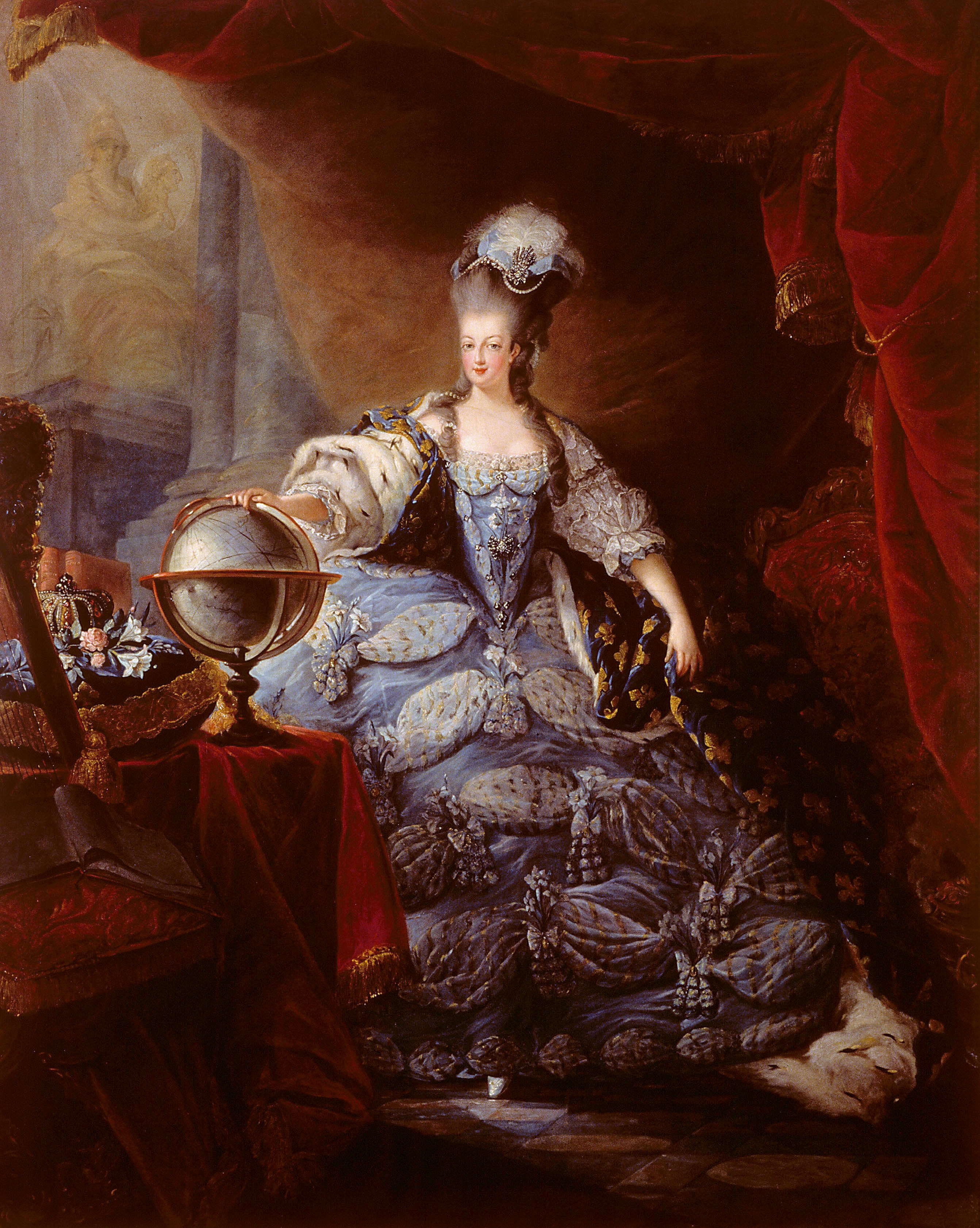
Marie Antoinette by Gautier-Dagoty, 1775, Palace of Versailles
While Marie Antoinette (1755-1793) cannot take credit for inventing the pouf, she is certainly responsible for its popularity. In 1774, when she became Queen of pre-Revolutionary France, over-the-top luxury was still very much the rage. For over a decade, fashionable French women had been raising, or poufing, their hair with woolen pads, coating and stiffening it with pomade made of beef lard or bear grease, and dusting it with wheat and corn powder. But, with the help of her Parisian milliner, Rose Bertin, and hairdresser, Léonard Autié, Marie Antoinette adopted the already established mode and took it to outrageous new heights. She made the pouf her signature look.
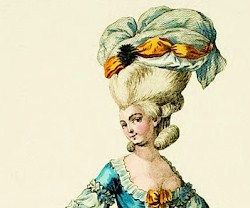
Fashion plate a la Marie Antoinette
The rumor mill buzzed with tales of her many lovers, gambling debts, and shopping addiction. Of Austrian blood, the French were suspicious of foreign queens. Could they trust her? They might love her or hate her, on this they could disagree. But on one point the French were united. They couldn’t take their eyes off her. Although the Queen was criticized for her extravagant fashion statements and excessive spending, aristocrats and commoners clambered to imitate her style. Paris—and soon, Europe—broke out in a rash of copycat poufs.

French fashion in the age of Marie Antoinette
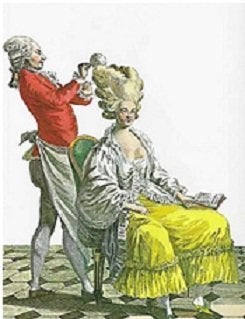 The pouf was halfway between a hairstyle and a hat. The thickly-powdered hair was teased away from the face then arranged high on the head on a wire scaffolding resembling a cone-shaped garden topiary. Next, the hairdresser added and intertwined false curls—curly, wavy, crimped— sometimes made of horsehair, diamond jewelry, ropes of pearls, yards of gauze, lace, and ribbon, pompoms, ostrich and peacock feathers, bows, rosettes, butterflies, figurines, and props. With such ornamentation, the stylist then set about to create a miniature still-life upon this rickety foundation. The theme of the elaborate, yard-high headdress could be a sentiment, a commemoration of an event, or an expression of a political opinion. The creativity was inexhaustible.
The pouf was halfway between a hairstyle and a hat. The thickly-powdered hair was teased away from the face then arranged high on the head on a wire scaffolding resembling a cone-shaped garden topiary. Next, the hairdresser added and intertwined false curls—curly, wavy, crimped— sometimes made of horsehair, diamond jewelry, ropes of pearls, yards of gauze, lace, and ribbon, pompoms, ostrich and peacock feathers, bows, rosettes, butterflies, figurines, and props. With such ornamentation, the stylist then set about to create a miniature still-life upon this rickety foundation. The theme of the elaborate, yard-high headdress could be a sentiment, a commemoration of an event, or an expression of a political opinion. The creativity was inexhaustible.
One of Marie Antoinette’s earliest poufs was the pouf à l’inoculation to publicize her triumph in persuading the King to be vaccinated against smallpox. Perched in the hairdo was a serpent in an olive tree (symbols of wisdom and Aesculapius), behind which rose the golden sun of enlightenment. When the French supported the Americans in their revolution, Marie Antoinette showed her support by wearing a pouf à la Belle Poule. The intricate hairdo featured a French ship that had won a decisive victory against the British in June 1778.
The ship itself, with its masts, rigging, and guns, was imitated in miniature on the pouf. This elaborate creation, a celebration of sorts, was an overnight success. It should be noted, however, that many such coifs were supported with wired scaffolding and were very heavy.
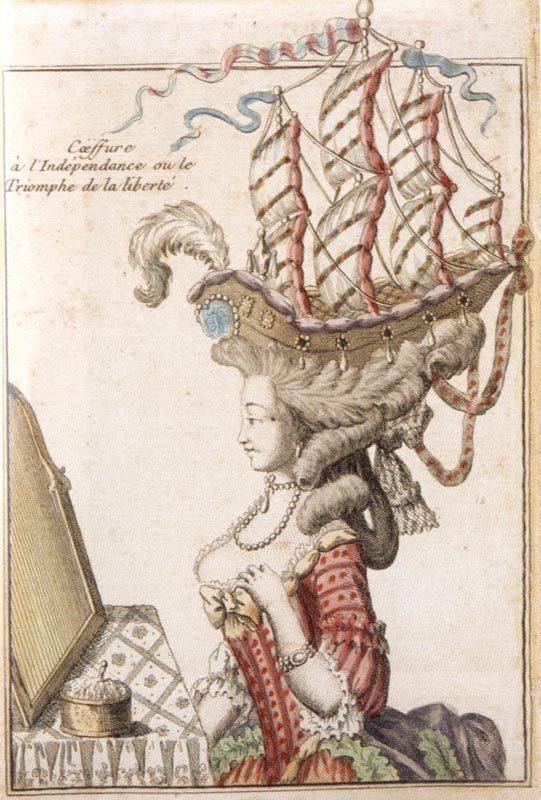
Marie Antoinette’s fashion nod to France’s role in the American Revolution. The hairdo is the Pouf á la Belle Poule.
The poufs were almost impossible to wash and became breeding grounds for vermin. They were itchy and uncomfortable. Women used special head-scratchers to alleviate some of the agony. Because they were so expensive to create, many women wore them for a week or more and were obliged to sleep virtually upright upon a mound of pillows. Top-heaviness made dancing difficult. Riding in a carriage was problematic. To keep from ruining her towering pouf, a woman might end up kneeling on the floorboard on the way to a ball or even leaning her head out the window. Satirical cartoons poked fun at these slaves to fashion.
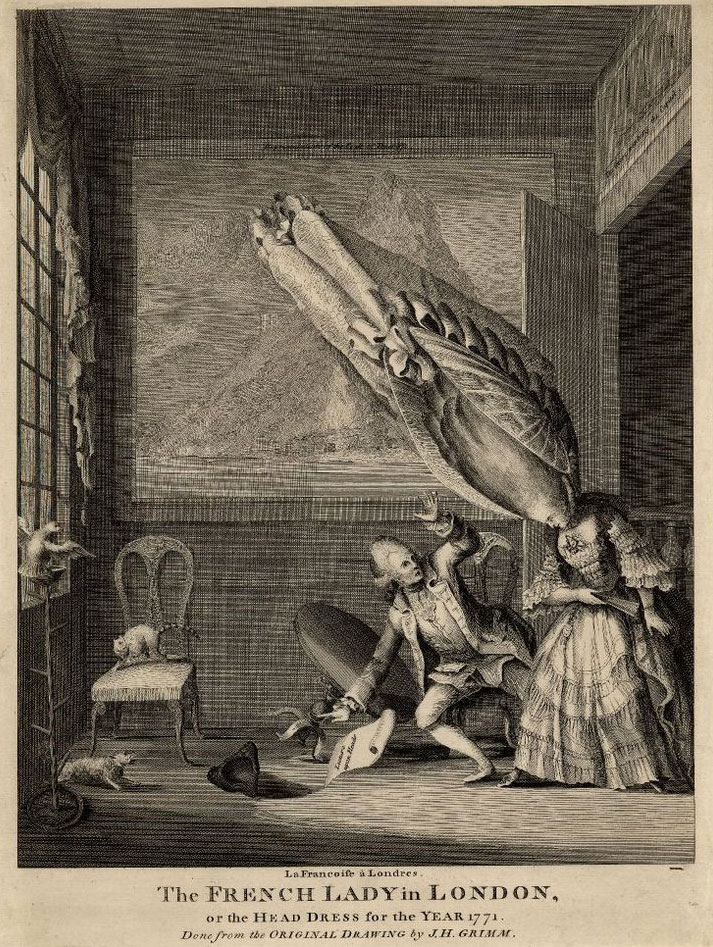
This British satirical etching commented on the French fashion for tall hairstyles, circa 1771. Image courtesy the British Museum.
Ever establishing new and exotic trends, Marie Antoinette spent a lifetime creating her identity as the nation’s most celebrated and reviled fashion plate. The attention she commanded came at a price. During the French Revolution, she was blamed for the country’s financial crisis. Hidden away in luxury at the Palace of Versailles, she and her husband, King Louis XVI, were oblivious to the plight of the French working classes, starving for bread and suffering from years of poor harvests, rising food prices, and an unfair tax system. Their anger boiled over. In October 1789, an angry mob of perhaps ten thousand market women and their allies descended on Versailles with spears, pikes, kitchen blades, and cannons, calling for the Queen’s death. At the Palace, they beat and slaughtered guards. They compelled the King and Queen to return with them to Paris. The twelve-mile return walk took nine hours as the mob had swelled to sixty thousand. Some of the marchers paraded the shorn heads of royal guards on their upraised pikes.

An illustration of the Women’s March on Versailles, October 5-6, 1789. Artist Unknown. Bibliothèque nationale de France
Over the next two years, the Revolution moved to The Terror. The King was executed. Nine months later, on October 14, 1793, Marie Antoinette’s trial began. Two days later, the Queen was convicted of high treason by the Revolutionary Tribunal and executed by guillotine on the Place de la Révolution. Marie Antoinette’s reign as Queen of France had ended but her reign as Queen of Fashion had not:
Shortly after the guillotine sliced its own bloody version of a necklace in the Queen’s throat, well-born women in Paris began tying thin red ribbons around their necks as reminders of what they might soon suffer.
Sources
Weber, Caroline. Queen of Fashion: What Marie Antoinette Wore to the Revolution Erickson, Carolly. To the Scaffold: The Life of Marie Antoinette Fraser, Antonia. Marie Antoinette: The Journey The Smithsonian. "Marie Antoinette" wikipedia. "Marie Antoinette" History Hoydens. "Can You Top This? Marie Antoinette's Hairstyles" Collectors Weekly. "Fashion to Die For: Did an Addiction to Fads Lead Marie Antoinette to the Guillotine?" Huffington Post. "Marie Antoinette's Craziest, Most Epic Hairstyles" BibliOdyssey. "Waiter, There's a Hair in My Satire" wikipedia. "Women's March on Versailles"


















